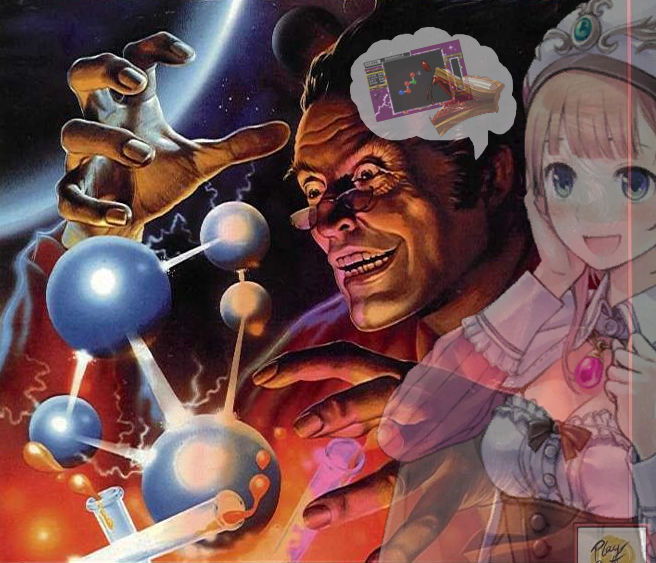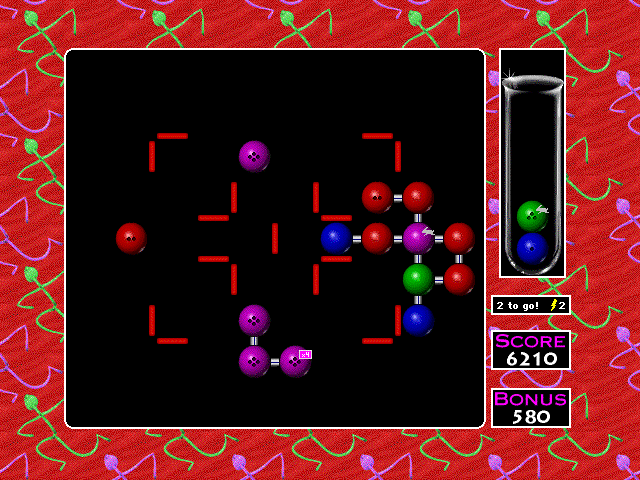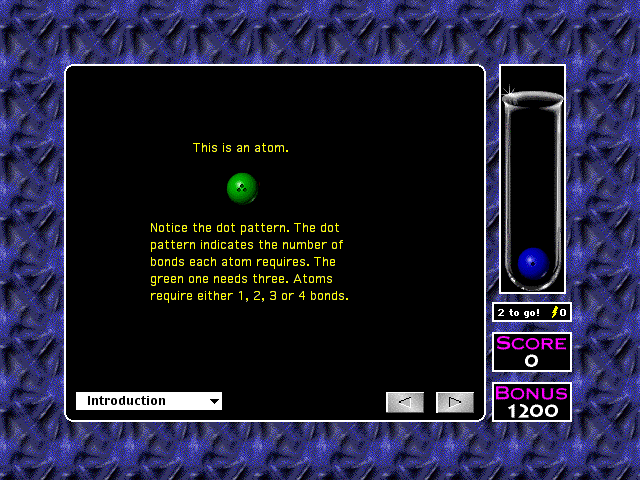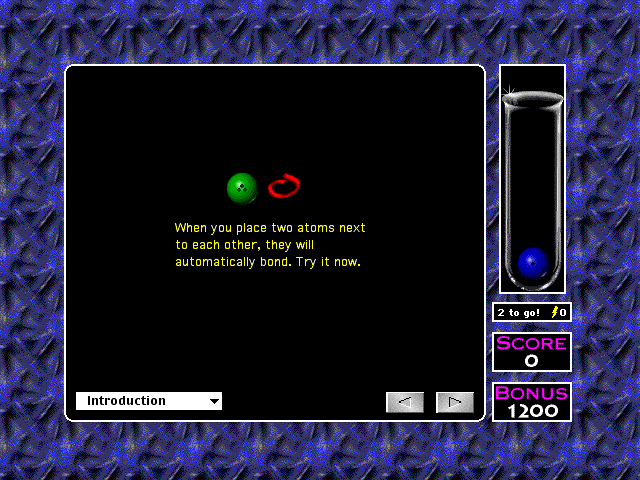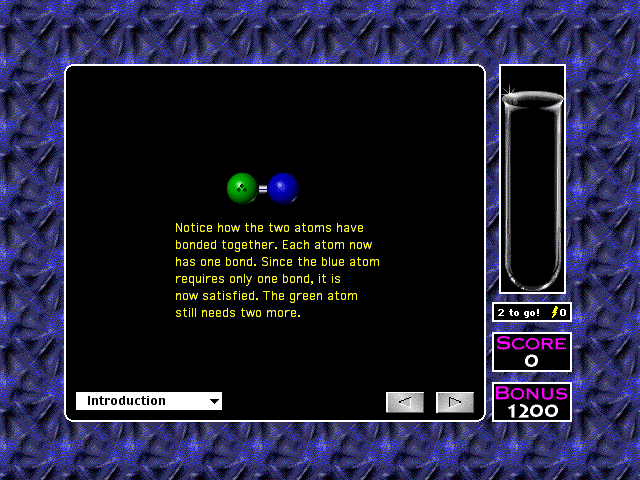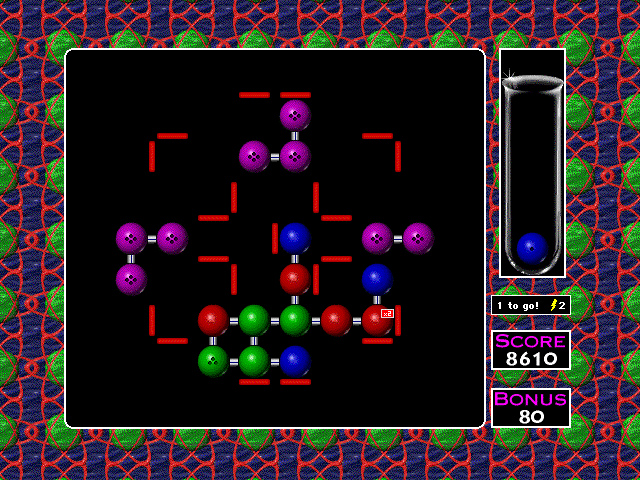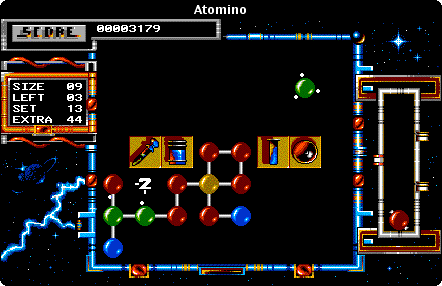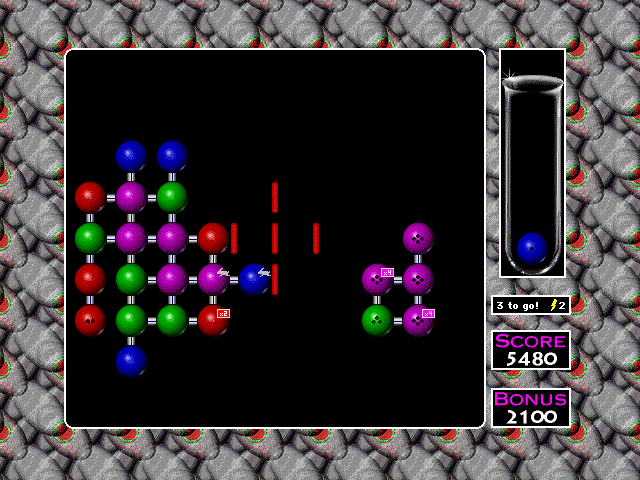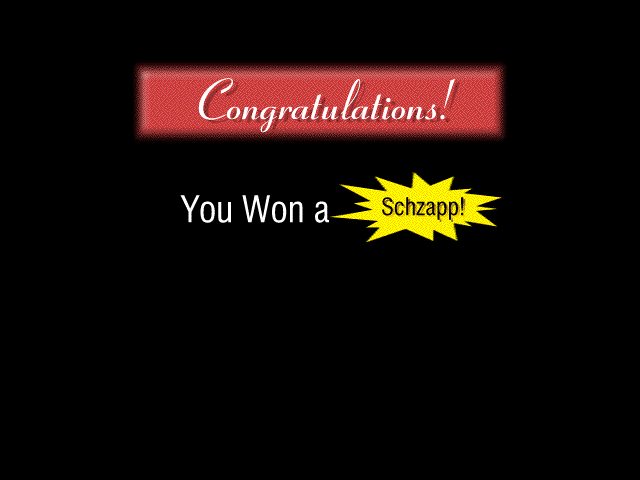Chiral – Chris Powell/Andrew Welch/Ambrosia Software - 1994 - First time playing?: Yes!
 After simply remaking Asteroids with pre-rendered CG graphics, it was time for Ambrosia Software to make their first original game. They completely failed at this and accidentally remade Atomino for Amiga. The reason I say “accidentally” is because in spite of the gameplay of Chiral being nearly identical to Atomino, the two developers of Chiral, Trevor Powell and Andrew Welch, both claim that they had never even seen Atomino during all of development. Trevor went on to say he got a look at Atomino after completing the game and could see the comparison, while Andrew insisted even after the game was released and after the accusations that he had never even seen a screenshot of Atomino.
After simply remaking Asteroids with pre-rendered CG graphics, it was time for Ambrosia Software to make their first original game. They completely failed at this and accidentally remade Atomino for Amiga. The reason I say “accidentally” is because in spite of the gameplay of Chiral being nearly identical to Atomino, the two developers of Chiral, Trevor Powell and Andrew Welch, both claim that they had never even seen Atomino during all of development. Trevor went on to say he got a look at Atomino after completing the game and could see the comparison, while Andrew insisted even after the game was released and after the accusations that he had never even seen a screenshot of Atomino.
Now, this may come as a shock to you, but I don't know much about molecular science. Maybe this is actually just a faithful recreation of atomic chemistry and these gameplay mechanics are the only way to recreate such a science through the medium of a video game. Or maybe the second you learn what a bound atom is, the Goddess of Alchemy herself transmits the design documents to this game directly into your brain alongside her favourite pie recipes. That’s the epiphany that the alchemist on the cover of Atomino was having, you just couldn’t see the science magic because you don’t have a phd. Here’s an artistic rendition of how it went down.
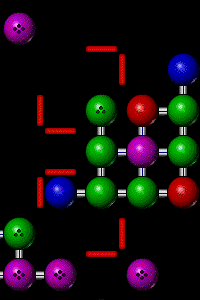 I sincerely hope at least one person reading this understood my stupid Atelier Rorona joke.
I sincerely hope at least one person reading this understood my stupid Atelier Rorona joke.
But as this probably gives away, I highly doubt Ambrosia’s claims that all similarities to Atomino in Chiral were incidental. I would genuinely have an easier time believing that Ambrosia’s developers had never seen Asteroids before developing Maelstrom, as that game has significantly more deviations from the source material. Chiral is a little too one-to-one with its theming and mechanics, but who knows. If one guy was able to come up with the idea on their own, it's not statistically impossible that someone else couldn't independently come up with the same idea, in the same way that the monkey with a typewriter and infinite time will ‘almost certainly’ eventually write Hamlet. I don’t want to throw accusations around claiming the developers are lying or anything, as this is one of those situations where it’s near impossible to provide evidence for or against. It is however, very difficult to discuss Chiral without comparing it to Atomino just because they’re so similar, not helped by the fact that personally I think Atomino is the better game that I'm more likely to recommend over Chiral.
Honestly, I wasn't feeling Chiral at first. It did just feel like an inferior Atomino without enough interesting ideas of its own to really warrant much enthusiasm. After a few more rounds however, the game did eventually click. My screenshot of the high score board up at the top of this review neatly demonstrates the point at which it clicked, as is obvious by the massive jump between my first place and second place scores. Chiral is far from one of my Ambrosia favourites, but it's by no means bad either.
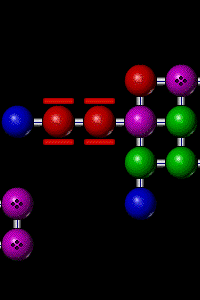 There is a story here surprisingly, other than just “science”. Turns out a bunch of atomic scientists were trying to make a new clean energy source, but screwed up and instead unleashed an infinite unstoppable supply of unstable atoms upon the earth. You need to make those atoms into stable molecules at a faster rate than they're spawning in or else, I dunno, the world implodes or something.
There is a story here surprisingly, other than just “science”. Turns out a bunch of atomic scientists were trying to make a new clean energy source, but screwed up and instead unleashed an infinite unstoppable supply of unstable atoms upon the earth. You need to make those atoms into stable molecules at a faster rate than they're spawning in or else, I dunno, the world implodes or something.
Complicated as bonding atoms and building molecules may sound, Chiral is actually pretty simple. Clicking anywhere on the play field will place the atom at the bottom of the vial on the right at that location. Place another atom next to it and those two atoms will bond, indicated by a line being drawn between the two atoms. The dots on the atoms indicate the maximum amount of bonds that the singular atom is capable of. So for instance, an atom with three dots on it can be bonded to three adjacent atoms, but if you place a fourth atom next to it, it won't bond. Once all connected atoms are bonded to their maximum number of adjacent atoms (indicated by the dots being removed from the atom’s sprite), that cluster becomes a molecule and is removed from the play field.
Your objective in each level is to create a set amount of molecules with a minimum size they must surpass. For instance, you may be required to create two molecules with at least ten atoms each. The faster you make the molecules and the less stray atoms you leave on the play field, the more bonus points you'll be awarded with. Later levels additionally add red walls that will prevent atoms on opposite sides of the wall from bonding, which gradually get more and more maze-like. As you play, more and more atoms will be added to the vial on the right at a gradually accelerated rate. If the vial overflows, you lose a life. Well, the extra lives are called schzapps, but same thing really.
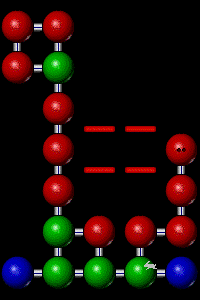 Even on practice difficulty, the vial fills up pretty quickly. In my early attempts I made the mistake of trying to thoughtfully position every single atom and make massive molecules that fill the whole screen, but that is going to result in a worse score as well as being more dangerous. Chiral is more about speedily building smaller molecules to get the time bonuses. Building multiple molecules at once additionally can ensure that even if the game isn't giving you the specific atom you need to finish the main molecule you were working on, you still have use for the atoms the game is giving you in the meanwhile. In general, purple atoms should go in the centre of the molecule, while the atoms that require less bonds should go on the edges of the molecule.
Even on practice difficulty, the vial fills up pretty quickly. In my early attempts I made the mistake of trying to thoughtfully position every single atom and make massive molecules that fill the whole screen, but that is going to result in a worse score as well as being more dangerous. Chiral is more about speedily building smaller molecules to get the time bonuses. Building multiple molecules at once additionally can ensure that even if the game isn't giving you the specific atom you need to finish the main molecule you were working on, you still have use for the atoms the game is giving you in the meanwhile. In general, purple atoms should go in the centre of the molecule, while the atoms that require less bonds should go on the edges of the molecule.
What if you place an atom somewhere really stupid, though? Are you just screwed then? No, because by clicking on an atom on the field, you can swap that atom with the atom at the bottom of the vial. Sometimes, replacing atoms with other atoms that require less bonds can help you complete a molecule far faster, rather than continuously building upon the edges. This also allows you to place atoms already on the field in different locations, since the atom you swapped out is now at the bottom of your vial and ready to be placed somewhere else.
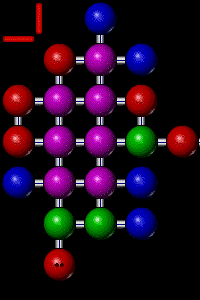 So far, this has all been identical to Atomino with three minor exceptions; the schzapps mechanic, the faster rate at which the vial fills up, and the fact that the 4-bond atom in Chiral is purple, whereas the 4-bond atom in Atomino is yellow. The rest is one-to-one with Atomino, from the colour coding of every other atom, to the vial being able to hold a maximum of five atoms, as well as the level objectives consisting of “build x amount of molecules with x amount of atoms minimum”. That's not all that's new here however, as there's a greater variety of atoms in Chiral. Atoms with a bowling ball-like texture are heavy and can not be moved after being placed, preventing you from swapping them. Atoms with a rabbit on them increase the speed at which the vial fills up for as long as they're present on the play field. Atoms with multipliers on them multiply the point value of the molecule they're used in, as you'd expect. Finally, the nuclear atom can be used to remove an unfinished molecule from the play field, in case it's getting in the way and it would be better to simply destroy it and start again rather than continue attempting to complete it and failing.
So far, this has all been identical to Atomino with three minor exceptions; the schzapps mechanic, the faster rate at which the vial fills up, and the fact that the 4-bond atom in Chiral is purple, whereas the 4-bond atom in Atomino is yellow. The rest is one-to-one with Atomino, from the colour coding of every other atom, to the vial being able to hold a maximum of five atoms, as well as the level objectives consisting of “build x amount of molecules with x amount of atoms minimum”. That's not all that's new here however, as there's a greater variety of atoms in Chiral. Atoms with a bowling ball-like texture are heavy and can not be moved after being placed, preventing you from swapping them. Atoms with a rabbit on them increase the speed at which the vial fills up for as long as they're present on the play field. Atoms with multipliers on them multiply the point value of the molecule they're used in, as you'd expect. Finally, the nuclear atom can be used to remove an unfinished molecule from the play field, in case it's getting in the way and it would be better to simply destroy it and start again rather than continue attempting to complete it and failing.
Now, once again, let us talk about Ambrosia Software’s bizarre sound design choices, because Chiral’s sound might be the most bizarre I've heard yet. A puzzle game based on atomic science probably is not making you think of a seductive baritone man whispering in your ear that “it's got to be funky, ohhh baby” all the while disco music is playing, but that's absolutely what you're getting. I don't really like it. The corny disco music isn't as appealing to me as the atmospheric drones of Maelstrom or the equal parts goofy and suspenseful theme of Apeiron, nor do Chiral’s sound effects have that same satisfying punch of those games. I know a puzzle game inherently isn't going to have sound effects as violently impactful as those in arcade shoot-em-ups, but the music and sound effects in Atomino are so much better than Chiral’s. Heck, Chiral doesn’t even have any kind of satisfying animation for when you complete a molecule and it’s cleared off of the play field. In Atomino, a completed molecule is removed from the playfield with a satisfying burst of light, but in Chiral, the molecule is just removed from the play field in a single frame with no animation at all.
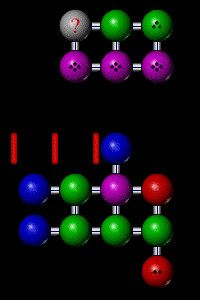 In general, Atomino’s presentation is leagues above Chiral, to an extent that does make me wonder if the devs were sincere about not having seen Atomino before, as it's hard to imagine someone cloning Atomino but leaving out the visual touches that both make the game look better and also make it much more readable. For instance, unlike Chiral where the maximum amount of bonds an atom is capable of is indicated by a static amount of dots present on the atom itself, Atomino instead represents this concept with electrons orbiting around the atom in question. Every time that atom is bonded to another atom, one of the neutrons is removed, giving more visual feedback on how many more bonds an atom needs to be completed. Furthermore, mousing over a tile on the play field shows an outline depicting exactly what atoms the placed atom will bond with before placing it. These features could have gone a long way to improving Chiral, as being able to quickly read the game board is essential due to how much faster paced Chiral is than Atomino.
In general, Atomino’s presentation is leagues above Chiral, to an extent that does make me wonder if the devs were sincere about not having seen Atomino before, as it's hard to imagine someone cloning Atomino but leaving out the visual touches that both make the game look better and also make it much more readable. For instance, unlike Chiral where the maximum amount of bonds an atom is capable of is indicated by a static amount of dots present on the atom itself, Atomino instead represents this concept with electrons orbiting around the atom in question. Every time that atom is bonded to another atom, one of the neutrons is removed, giving more visual feedback on how many more bonds an atom needs to be completed. Furthermore, mousing over a tile on the play field shows an outline depicting exactly what atoms the placed atom will bond with before placing it. These features could have gone a long way to improving Chiral, as being able to quickly read the game board is essential due to how much faster paced Chiral is than Atomino.
While the different atom types present in Chiral may seem like more of a game changer than any other difference from Atomino, it's actually the faster pacing that changes how Chiral plays the most. In Atomino, not only does the vial fill much slower, but you are also required to clear the play field of all atoms after you've achieved the level objective before you can move onto the next stage. As a result, placing atoms carelessly and filling the screen with them is going to cause you much more long-term issues later on. Chiral meanwhile more or less encourages simply dumping atoms you don't have an immediate use for off to the side away from any molecules you're focusing on building, as not only does it prevent the vial from overflowing, but can also be used later on when you need it thanks to the swap mechanic. Plus, the nuclear atom also allows for clearing out clumps of useless atoms if they start to clutter the play field. Chiral is much more of an action puzzler compared to the slower moving “let's think ahead a bit here” style of Atomino, and that's what ends up differentiating the games the most.
Do I still like Atomino more? Yes. It looks better, sounds better and the more strategic pacing is more my style than the frantic “build this as fast as possible” style of Chiral. Do I think that this leaves Chiral without value? No. It ultimately is a different enough take on the concept to be if nothing else a change of pace, while also potentially appealing more to the types of people who want their puzzle games hectic. Ultimately, that is kind of all I have to say on Chiral however. Again the game’s not bad by any means, but it lacks the humour, character and even variety of Ambrosia’s Maelstrom and Apeiron that leaves me with less to comment on. One of the things that livened up those two games was the presence of random events that could happen at any time and wildly shake up the gameplay, such as Maelstrom’s supernovas or the power-up showers in Apeiron. Chiral isn’t like that, but I can’t imagine it would be easy to work such mechanics into this kind of game either, for the same reason that Tetris would not be improved by the addition of random earthquakes. Ultimately, Chiral isn’t quite my thing, but I can get why others may have more positive feelings towards it regardless.
- Page written by MSX_POCKY, 26th November 2025

